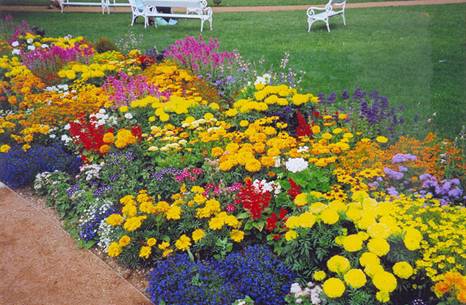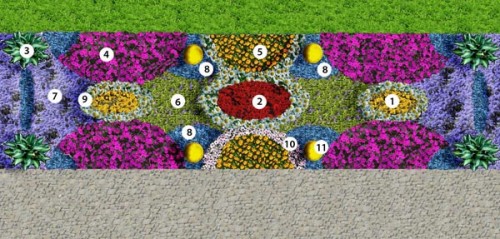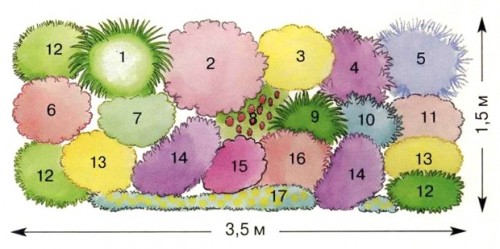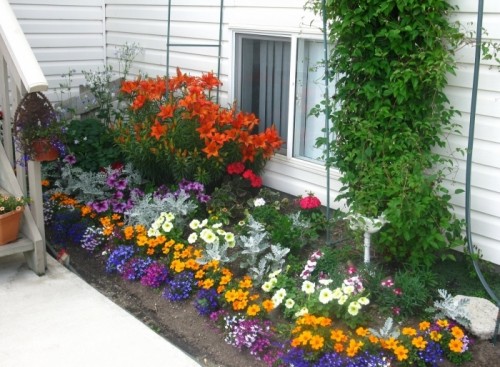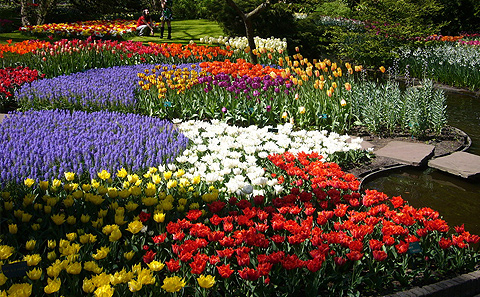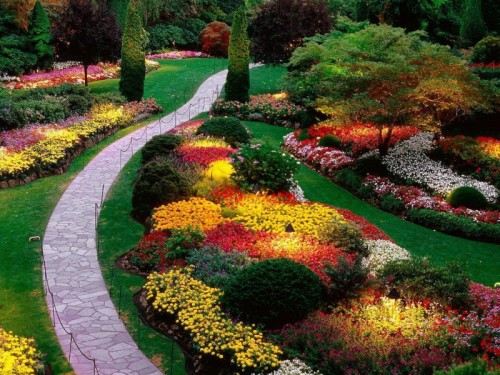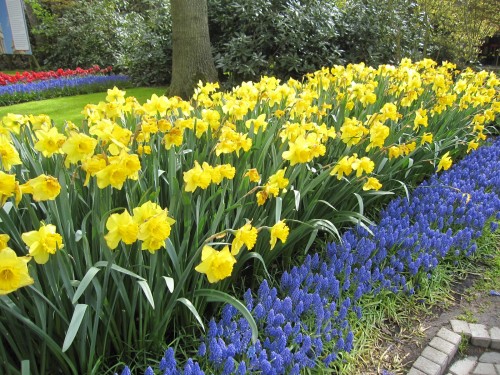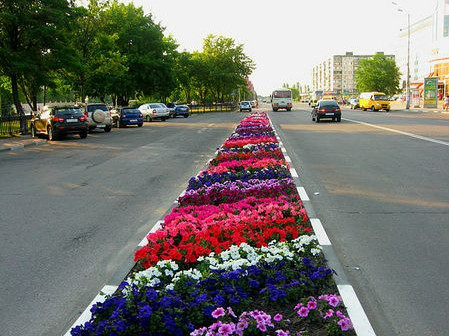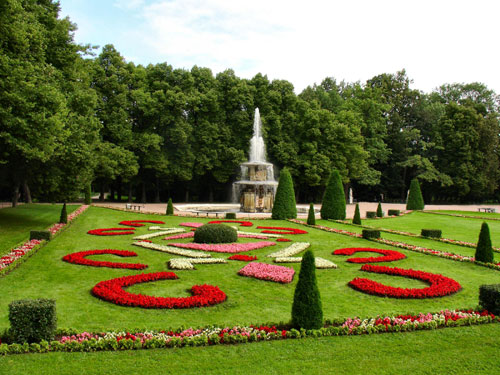Rabatka is the Pest of Flowerba, usually having a rectangular shape, but there are exceptions. The main distinctive feature is replays of shades and forms of plant elements. Typically, the Rabata is used in the design of the garden with a geometric style.
Content
Right approach to the construction of Rabata
If you have a lot of free time and the desire to make your garden beautiful, you can decorate it with your own hands with interesting Rabata. For this you need:
- Draw a scheme that you see Rabatka. Flowers can be placed differently, it can be smooth rows or intricate figures, and much attention should be paid to the combination of flowers and leaves.
- What width to make the pea depends on the total area of \u200b\u200bthe site. If he is not big, then the flower garden needs to be done no more than half a meter, otherwise it will be too saturated. If the space allows, then the slat can be more than 5 m long.
- If you are planning a long discount, then it must be broken by small flower beds, every five meters.
- To in a wide flower garden, water was not found in a perfectly smooth surface after a heavy rain, you need to make small tubercles in its center.
- Most designers adhere to the opinions that if there are flowers of one species in the Rabatka, they look good than if they were different-sided. If there are too many plants in the flower garden, it will look a little messy, it is enough to take no more than five varieties.
Plant landing patterns
Rabata can be planted in different schemes:
- You can take only one type of plants, in this case there are good colors, such as nasturtium, calendula, iris, field chamomiles and others. Interesting design is achieved due to the fact that plants of a single species are planted, but differ in color and variety.
- Planting 2-3 varieties of plants, the big color gamut does not need to be used so that it is not too Pestro, and the drawing is not lost. First of all, you need to choose which height of the plant will grow on a flowerbed, find out when they are about blooming how you build a color gamut.
Color diagram of Rabatka
For Rabata, the color scheme must be thought out before starting planting plants. In addition to the combination of colors, it is necessary that the plants differ also in terms of flowering. Then the flower garden will delight the eyes and spring, and summer, and autumn. You can land and decorative greens.
There should be one dominant color in the Rabata. If you want to get warm shades on the flower bed, then plant flowers of yellow or orange tones, and if cold is blue, blue and purple. You can try to play both in contrast, make a combination of blue with orange, yellow with purple. Beautiful will look at the chain of pastel tones.
All plants should be approximately the same for care requirements, otherwise, beautiful Rabata will not work.
Types of Rabatok.
One-sided slatkat
One-sided discount on the cottage is usually located near the fences, buildings and tracks. They have several features:
- They need to land, as close as possible to the wall. High plants need to be planted on the background, and those that lower on the first.
- The color of the facade or fence and the rabata should be combined. If the background is dark, the flowers are better to plant light, if the wall is in the cold color scheme, then the red, orange and burgundy flowers will be wonderful next to it.
- When falling out the colors, you need to pay attention so that there is no emptiness, through which a naked primer would be transformed.
- Flower bed in the form of a ladder always attracts attention, plants need to be planted in it with a different period of flowering.
- Juniper is suitable from high plants, and from low - carnations, phlox, roses and others.
Bilateral Rabatka
Types of double-sided Rabatok:
1. Single-line - plants are planted the same in height.
2. Bunk - in the center of the composition tall plants, surrounded by lowered.
For bilateral flower beds, as a rule, highlight the place in the very center of the garden so that they look at well from all sides. The advantage of this type of Rabatka is that perennial plants are planted, which are unpretentious in care. The main thing is to choose the right variety, so that the flowers please the eye constantly and not one season.
Here are some examples of beautifully decorated chains in the photo.
Other types of Rabatok
- Assymmetric Rabata. Typically, such ramids are built along the fences. Their feature is that low-spirited plants are planted not around the tall, but in front of them. Otherwise, you can build Rabatka as you want.
- Symmetric - they are located exactly in the middle of the site. And, as a rule, tracks from two sides.
- Intermittent - if it is planned to build a long-term discount, then it is better to make it from several segments that are interrupted. In places of rupture, large flowers are planting - peonies, roses. In these places, the slat can if necessary to change its direction.
Rabatka do it yourself
In order to make independent Rabata you will need:
- shovel;
- rake;
- watering can;
- fertile soil;
- plants for landing (bulbs, seeds, seedlings);
- material for border.
Make Rabata with your own hands very simple:
- Before proceeding with the markup, you need to draw an exemplary plan for the future flower garden on paper.
- Select a flower bed site on a plot.
- Drink pegs around the perimeter of future Rabata.
- Remove the upper soil reservoir by 15 cm.
- On the perimeter of the flower beds to establish a border, its purpose - to make Rabatka completed. A border can serve as a brick, concrete products that need to cut into parts and put vertically, or thick branches.
- Pour in the flower bed of Rabatka, prepared fertile mixture (it is possible, how to buy in special stores, and make it yourself, mixing the black soot with fertilizers. Good land for the flower garden can be found in the forest belts, removing the top layer of leaves under the trees. Some daches use for these purposes. And the soil from the tubercles, which went to the mole).
- Sprinkle plants by sticking to the color scheme.
- Flowers need to pour and then only take care: remove weeds, water, feed fertilizers.
Plants and Rabata Flowers
The choice of colors and plants is hardly the most important process in the creation and design of Rabat. To the flower bed look beautiful, you need to stick to some rules:
- In order for the Rabatka to begin to please his owners from the first days of spring, you need to tall long-term plants and shrubs, as soon as snow comes down, plant the first colors: snowdrops, daffodils and tulips. As soon as they blend, the bulbs carefully dig up, transplant them to the garden, and in their place to plant annual plants, such as poppy, velvets, petunia.
- If you do not have much time to care for the discount, then it is better not to plant subtropical plants, such as Chinese carnation or year. They look exotically, they require a lot of attention to themselves, instead you can land asters, binders, calendula and other, more familiar plants.
- In Rabata, it is desirable to make only one bright spot, disembarking, for example, Ageratum or Salvia, in this case all other plants must have a more modest color gamut. Such what daisies, peonies, roses have.
- If your slave will consist of only one type of colors, it is best to plant daisies, chrysanthemums, asters, irises.
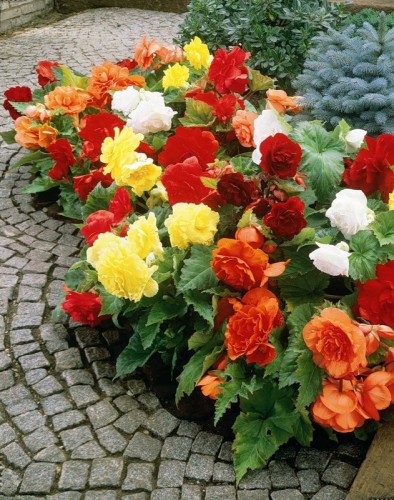
- Sophisticated drawings on the garden are best planted from Verbena, hosts, velvetsev.
- If the flowers do not have lush green leaves, decorative greens will come to the rescue in the design of Rabatka.
- Rhythm on the flowerbed can hold a bush of the koches, it can be cut in the shape of a ball. Such plants need to be planted along the entire length of the Rabata with equal repetition.
- To save Rabatka from sloppy, you must definitely dig out the blurred annual colors and plant new ones.
- It is interesting to look at the flower beds, in which annual plants are combined with some vegetables, for example, with leaf beets, red sharp pepper or with such spicy plants, like thyme, mint and oregano.
- Specialists are advised to adhere to such a scheme: per 1 square meter. M. Rabatki to plant no more than 4 high plants, 5 - medium and 9 - low plants.
- In Rabatka from perennials you need to plant plants so that their crowns come into contact. Thus, there will be no lumen. So that they do not arise after the plant will flash, it is necessary to alternate annual with perennial. Or the last to choose such to bloom later and bloom long.

